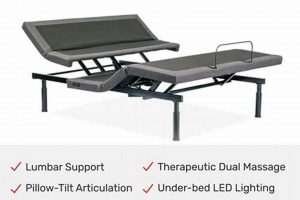A sleeping surface designed for larger bedrooms and couples, often measuring approximately 76 inches wide by 80 inches long, constructed using bamboo-derived materials for its cover and sometimes internal components. These products seek to offer a blend of comfort and potential environmental benefits. For example, a memory foam variant might incorporate a bamboo rayon cover designed to enhance breathability.
The appeal of these items lies in several factors. Bamboo is often touted as a sustainable resource due to its rapid growth and renewability. The resulting fabric can exhibit enhanced breathability and moisture-wicking properties compared to conventional materials like cotton. Historically, natural fibers have been valued for their comfort and perceived health benefits, and this trend continues with the increasing adoption of bamboo-based textiles in bedding.
The following sections will delve into the specific material compositions, advantages, potential drawbacks, and purchasing considerations related to these sleeping solutions. This will include information on construction, lifespan, care instructions, and certifications relevant to both the mattress itself and the bamboo-derived components used in its manufacturing.
Guidance on Selecting a Large Bamboo Mattress
The subsequent recommendations aim to assist in making an informed purchase decision regarding an expansive bamboo-enhanced sleeping surface. Attention to detail during the selection process can yield a comfortable and durable bedding solution.
Tip 1: Prioritize Density. Mattress density, especially in foam layers, correlates with durability. Higher density foams, while potentially more expensive initially, tend to resist compression and maintain their supportive qualities over extended use.
Tip 2: Examine the Bamboo Fabric Blend. The percentage of bamboo fiber within the cover fabric influences its breathability and moisture-wicking capabilities. Opt for higher bamboo content where feasible, considering any potential trade-offs in texture or cost.
Tip 3: Consider Underlying Support Systems. Whether the core is comprised of innersprings, foam, or a hybrid configuration, ensure the support system is adequate for the intended users’ body weights and sleeping preferences. Heavier individuals often require firmer support.
Tip 4: Scrutinize Certifications. Look for certifications such as OEKO-TEX Standard 100, which verifies the absence of harmful substances in the fabric components. This provides assurance regarding the product’s material safety.
Tip 5: Research Firmness Options. Firmness is a subjective characteristic. However, generally, side sleepers benefit from softer mattresses that contour to their bodies, while back and stomach sleepers often require firmer support to maintain spinal alignment.
Tip 6: Review Warranty Provisions. A comprehensive warranty demonstrates the manufacturer’s confidence in the product’s longevity. Pay close attention to the terms and conditions, including coverage for sagging, indentations, and manufacturing defects.
Tip 7: Inquire About Trial Periods. Many manufacturers offer trial periods, allowing for in-home testing. Take advantage of this opportunity to evaluate the mattress’s comfort and suitability before committing to a purchase.
Adherence to these guidelines promotes a more favorable selection process, leading to a purchase that aligns with individual needs and preferences. Consideration of these factors contributes to a more satisfactory sleep experience.
The ensuing sections will address maintenance protocols, potential health considerations, and long-term value assessments related to owning and utilizing a large-sized bamboo-enhanced sleeping surface.
1. Size Specifications
Size specifications are a foundational characteristic defining a king size bamboo mattress, exerting a direct influence on its suitability for particular bedrooms and user needs. The standard dimensions of approximately 76 inches in width by 80 inches in length dictate the required floor space and the capacity to comfortably accommodate two adults, particularly those who prefer ample personal space during sleep. Deviation from these standardized dimensions, even by minor increments, can result in incompatibility with existing bed frames, bedding accessories, and overall room aesthetics. Consequently, precise adherence to established king size specifications is paramount during manufacturing and purchasing to ensure a seamless integration within the intended sleep environment.
The correlation between size and comfort is especially pertinent. A king size mattress provides significantly more surface area compared to smaller alternatives, such as queen or full-size models. This added space minimizes sleep disturbances caused by partner movement and allows for greater freedom of positioning. The bamboo-derived components, such as the cover or comfort layers, further enhance this experience by offering breathability and moisture-wicking properties, promoting a more temperate and undisturbed sleep cycle. For example, a couple sharing a smaller mattress may experience frequent awakenings due to limited space and increased heat retention; the expanded surface area and breathable materials of a king size bamboo mattress can mitigate these issues.
In conclusion, the size specifications of a king size bamboo mattress are not merely descriptive; they are determinative of its functional value. Accurate dimensions ensure compatibility with existing infrastructure, while the increased surface area promotes superior comfort and reduced sleep disruption. This understanding underscores the importance of verifying size specifications during the selection process to guarantee that the chosen mattress meets the practical needs of the intended users and their sleep environment. Overlooking this fundamental aspect can lead to dissatisfaction and the need for costly replacements.
2. Material Composition
The material composition of a king size bamboo mattress is paramount, directly influencing its comfort, durability, and potential environmental impact. A comprehensive understanding of the constituent materials is essential for making an informed purchase decision.
- Bamboo-Derived Cover Textiles
The cover is frequently constructed from rayon or lyocell derived from bamboo pulp. These materials are valued for their breathability, moisture-wicking properties, and soft texture. For example, a mattress cover incorporating a high percentage of bamboo-derived fabric may feel cooler to the touch and help regulate body temperature during sleep. However, the specific manufacturing process can impact the final product’s environmental friendliness; closed-loop systems that recycle solvents are preferable.
- Comfort Layers: Foam Varietiestrong>
Underlying the cover are typically comfort layers, which may include memory foam, latex foam, or polyurethane foam. The density and composition of these foams contribute significantly to the mattress’s overall feel and support. For instance, a memory foam layer conforms to the body’s contours, providing pressure relief, while latex offers a more resilient and responsive feel. The presence of CertiPUR-US certification indicates that the foam has been tested for harmful substances.
- Support Core: Innersprings and Foam Alternatives
The support core provides the primary structural integrity of the mattress. Traditional innerspring systems utilize coils to distribute weight and provide support. Alternatively, foam-based cores offer a different type of support, often characterized by consistent firmness across the surface. Hybrid mattresses combine both innerspring and foam elements. The gauge and arrangement of the coils in an innerspring system, or the density of the foam core, directly correlate with the mattress’s ability to support weight and maintain its shape over time.
- Fire Retardant Barriers
Federal regulations mandate that mattresses include a fire retardant barrier. Traditional chemical-based fire retardants are increasingly being replaced by alternatives such as silica or wool. These materials provide the necessary fire protection without the potential health concerns associated with certain chemicals. Transparency regarding the specific fire retardant used is a crucial consideration for health-conscious consumers.
The interplay between these constituent materials dictates the overall performance of a king size bamboo mattress. For instance, a high-density foam core paired with a breathable bamboo-derived cover can provide both robust support and enhanced temperature regulation. Conversely, a low-density foam core may result in premature sagging, regardless of the cover’s material. Therefore, evaluating the material composition as a whole, rather than focusing solely on the bamboo element, is essential for selecting a mattress that delivers long-term comfort and value.
3. Firmness Level
Firmness level represents a crucial characteristic of any king size bamboo mattress, significantly influencing spinal alignment, pressure point relief, and overall sleep comfort. Selecting an appropriate firmness level is paramount for maximizing the benefits of a larger mattress, particularly when accommodating diverse sleeping preferences or physical requirements.
- Subjectivity and Scale
Firmness is inherently subjective, yet generally categorized along a scale from extra-soft to extra-firm. Manufacturers often employ numerical scales (e.g., 1-10) to provide a more standardized indication. A “medium” firmness, typically around 5 or 6, aims to strike a balance between support and cushioning, suitable for a broad range of sleepers. However, individual perception varies based on body weight, sleeping position, and personal preferences. For instance, a lighter individual may perceive a mattress as firmer than a heavier individual would.
- Influence on Spinal Alignment
The primary function of a mattress, regardless of size or material, is to maintain proper spinal alignment during sleep. Firmness plays a direct role in achieving this goal. Side sleepers generally benefit from softer mattresses that allow the shoulder and hip to sink in, preventing spinal curvature. Back sleepers often require medium-firm to firm mattresses to support the natural curve of the lower back. Stomach sleepers typically need firmer surfaces to prevent excessive sinking of the midsection, which can lead to lower back pain. A king size mattress allows for each sleeper to have space regardless of their firmness preference.
- Impact on Pressure Point Relief
Excessive pressure on bony prominences, such as the hips, shoulders, and knees, can lead to discomfort and disrupted sleep. Softer mattresses generally provide better pressure relief by conforming to the body’s contours. However, overly soft mattresses may lack adequate support, leading to spinal misalignment. The ideal firmness level balances pressure relief with sufficient support. King size mattresses with zoned support, where different areas of the mattress offer varying levels of firmness, can address pressure relief and spinal alignment simultaneously.
- Considerations for Couples
Couples often have differing firmness preferences, making mattress selection challenging. King size mattresses offer the advantage of accommodating split firmness configurations, where each side of the mattress has a different firmness level. Alternatively, a medium-firm mattress may serve as a compromise, although individual toppers can be added to customize each side to individual preferences. A split king base is also a good choice.
Ultimately, the optimal firmness level for a king size bamboo mattress depends on a complex interplay of individual factors. Trialling different firmness levels, either in a showroom or through a home trial period, is recommended to ensure a satisfactory sleep experience. The breathability of the bamboo cover can further enhance comfort, regardless of the selected firmness level.
4. Support System
The support system within a king size bamboo mattress constitutes the core structural element responsible for distributing weight, maintaining spinal alignment, and influencing the mattress’s overall longevity. Its composition and design directly impact the sleep experience and the mattress’s ability to provide consistent comfort over time.
- Innerspring Cores
Innerspring systems utilize interconnected coils to provide support. Coil count, gauge (thickness), and configuration (e.g., Bonnell, pocketed) influence the firmness and responsiveness. Higher coil counts and thicker gauges generally indicate greater durability and support. Pocketed coils, where each coil is individually encased, minimize motion transfer, a significant benefit in a king size mattress shared by two individuals. For example, a king size innerspring mattress with 800 pocketed coils may provide superior motion isolation compared to a similar mattress with a Bonnell coil system.
- Foam Cores
Foam cores, often composed of high-density polyurethane or latex, offer an alternative to innerspring systems. These cores provide consistent support across the entire mattress surface and tend to be quieter than innerspring options. Density is a key indicator of foam core quality; higher density foams resist compression and maintain their shape longer. A king size mattress with a high-density foam core may exhibit less sagging over time compared to one with a lower-density core. These cores often work well with adjustable beds.
- Hybrid Systems
Hybrid support systems combine elements of both innerspring and foam cores. Typically, these mattresses feature a layer of pocketed coils for support and motion isolation, topped with layers of foam (memory foam, latex, or polyurethane) for comfort and pressure relief. Hybrid systems aim to deliver the benefits of both innerspring and foam designs. For example, a king size hybrid mattress may offer the responsive support of an innerspring system with the contouring comfort of a memory foam layer.
- Ed
ge SupportEdge support refers to the reinforcement provided along the perimeter of the mattress. Strong edge support prevents sagging and allows sleepers to utilize the entire surface area of the mattress comfortably. Edge support systems may involve reinforced coils, high-density foam encasements, or a combination of both. In a king size mattress, robust edge support is particularly important, as individuals may be more likely to sleep near the edges. Without adequate edge support, the edges of the mattress may compress over time, reducing usable sleeping space.
The selection of a suitable support system for a king size bamboo mattress should be predicated on factors such as body weight, sleeping position, and partner preferences. Regardless of the chosen support system, the presence of a bamboo-derived cover can enhance breathability and moisture-wicking, contributing to a more comfortable sleep environment. However, the support system remains the fundamental structural component that dictates the mattress’s long-term performance and ability to promote restful sleep.
5. Breathability
Breathability, in the context of a king size bamboo mattress, refers to the mattress’s capacity to facilitate air circulation and dissipate heat and moisture. This characteristic is vital for maintaining a comfortable sleep environment, particularly given the larger surface area of a king size mattress and its potential to trap heat.
- Fiber Structure and Airflow
Bamboo fibers, when processed into rayon or lyocell for mattress covers, possess inherent structural properties that promote airflow. The microscopic channels within the fibers allow for efficient ventilation, enabling the dissipation of body heat and moisture. For example, a tightly woven synthetic cover may restrict airflow, leading to increased heat retention, whereas a bamboo-derived cover allows for greater evaporative cooling, mitigating discomfort. This natural air circulation is especially important in a larger mattress where more body heat is likely to accumulate.
- Moisture-Wicking Capability
Bamboo fibers exhibit superior moisture-wicking capabilities compared to synthetic materials. This property allows the mattress cover to absorb and evaporate perspiration, preventing the buildup of humidity that can lead to discomfort and bacterial growth. For instance, during sleep, the human body releases moisture; a bamboo cover actively draws this moisture away from the skin, promoting a drier and cooler sleep surface. This is particularly relevant for individuals prone to night sweats or those living in humid climates.
- Impact on Temperature Regulation
Effective breathability directly contributes to temperature regulation. By facilitating airflow and wicking away moisture, a king size bamboo mattress minimizes heat buildup, helping to maintain a consistent and comfortable sleep temperature. This is crucial for preventing overheating, which can disrupt sleep cycles. For example, a mattress lacking breathability may cause the sleeper to feel excessively warm, leading to restlessness and frequent awakenings, while a breathable mattress promotes a more stable and restful sleep.
- Interaction with Other Mattress Components
The breathability of a king size bamboo mattress is not solely determined by the cover fabric; it also depends on the composition of the underlying comfort and support layers. Open-cell foam structures, such as those found in certain memory foam or latex formulations, enhance airflow throughout the mattress. Conversely, dense, closed-cell foam can impede breathability, negating some of the benefits of the bamboo cover. Therefore, a holistic evaluation of all mattress materials is essential for assessing its overall breathability.
In conclusion, the breathability of a king size bamboo mattress is a multifaceted characteristic determined by the interaction of fiber structure, moisture-wicking capability, temperature regulation, and the composition of other mattress components. This attribute is particularly important in larger mattresses, where heat and moisture accumulation can be more pronounced. A breathable mattress promotes a more comfortable and restful sleep experience, mitigating temperature fluctuations and promoting a drier sleep surface.
6. Certifications
Certifications serve as independent verifications of a king size bamboo mattress’s composition, manufacturing processes, and claims regarding material safety and environmental impact. These certifications, issued by recognized third-party organizations, provide consumers with a degree of assurance beyond marketing assertions. For instance, a king size bamboo mattress bearing the OEKO-TEX Standard 100 certification has been tested for harmful substances, ensuring that the textiles used in its construction meet stringent limits for chemicals like formaldehyde, heavy metals, and pesticides. The presence of such a certification directly affects consumer confidence, as it mitigates concerns about potential health risks associated with prolonged contact with the mattress materials. Without these certifications, consumers are largely reliant on the manufacturer’s self-reported claims, which may lack independent validation.
The significance of certifications extends beyond material safety. Certifications like the Global Organic Textile Standard (GOTS) verify the organic status of the bamboo fibers used in the mattress cover. This certification ensures that the bamboo was grown and processed according to specific organic farming practices, minimizing the use of synthetic pesticides and fertilizers. The Forest Stewardship Council (FSC) certification, applicable to wood components used in the mattress foundation (if any), confirms that the wood was sourced from responsibly managed forests. These environmental certifications are particularly relevant for consumers seeking sustainable bedding options. A king size bamboo mattress claiming environmental benefits without supporting certifications may be engaging in “greenwashing,” misleading consumers about its true environmental impact.
In summary, certifications are a critical component in evaluating a king size bamboo mattress. They provide independent validation of claims regarding material safety, organic content, and sustainable sourcing. While the presence of certifications does not guarantee a superior sleep experience, it offers a level of transparency and assurance that empowers consumers to make informed purchasing decisions. The absence of relevant certifications should prompt further scrutiny, as it may indicate a lack of independent verification or a reluctance to meet established industry standards. Consumers prioritizing health, environmental sustainability, or ethical sourcing should prioritize mattresses with relevant and reputable certifications.
Frequently Asked Questions
The following section addresses common inquiries regarding king size mattresses incorporating bamboo-derived materials. These answers aim to provide clarity and assist in making informed purchasing decisions.
Question 1: What are the dimensions of a standard king size bamboo mattress?
A standard king size mattress, including those utilizing bamboo-derived components, measures approximately 76 inches in width and 80 inches in length. These dimensions are crucial for ensuring compatibility with king size be
d frames and bedding.
Question 2: Is a king size bamboo mattress inherently more eco-friendly than other mattresses?
While bamboo is often touted as a sustainable resource, the overall environmental impact depends on factors beyond the bamboo cover. Manufacturing processes, the use of chemicals, and transportation contribute to the ecological footprint. Look for certifications such as GOTS or OEKO-TEX to verify sustainable practices.
Question 3: How does the bamboo component in a king size mattress affect its breathability?
Bamboo fibers, when processed into rayon or lyocell, exhibit enhanced breathability compared to synthetic materials. This can improve air circulation and moisture-wicking properties, potentially reducing heat retention during sleep. However, the breathability of other mattress components also influences the overall effect.
Question 4: What is the typical lifespan of a king size bamboo mattress?
The lifespan varies depending on factors such as material quality, construction, and usage. A high-quality king size mattress, regardless of the bamboo component, can last between 7 to 10 years with proper care. Regular rotation and the use of a mattress protector can extend its lifespan.
Question 5: Are king size bamboo mattresses suitable for individuals with allergies?
Bamboo fibers are often touted as hypoallergenic. However, allergic reactions are complex, and individuals may react to other components within the mattress, such as latex or certain chemicals. It is crucial to review the material composition thoroughly and consider allergy testing if concerns exist.
Question 6: How should a king size bamboo mattress be cleaned and maintained?
Regular vacuuming helps remove dust and allergens. Spot cleaning with a mild detergent is recommended for spills. Avoid harsh chemicals and excessive moisture, which can damage the mattress. Using a mattress protector is essential for preventing stains and prolonging the mattress’s lifespan.
In conclusion, careful consideration of these frequently asked questions, alongside thorough product research, enables a more informed decision when selecting a king size bamboo mattress.
The subsequent section will offer guidance on comparing and contrasting different brands and models within the king size bamboo mattress market, emphasizing key differentiating factors.
Conclusion
The preceding analysis has explored various facets of the king size bamboo mattress, encompassing material composition, firmness levels, support systems, breathability, and certifications. The discussion underscored the importance of discerning the interplay between bamboo-derived components and other materials in determining overall performance and value. Furthermore, the role of independent certifications in validating manufacturer claims concerning safety and sustainability was emphasized.
Ultimately, selecting a king size bamboo mattress necessitates a comprehensive evaluation of individual needs, preferences, and priorities. Further research into specific brands and models is strongly encouraged to ensure alignment with personal requirements and to maximize satisfaction with this significant investment. Careful consideration of the factors outlined herein should facilitate a more informed and judicious purchasing decision.


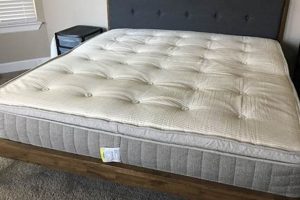
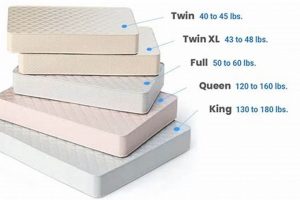
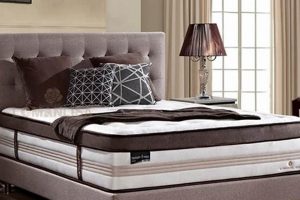
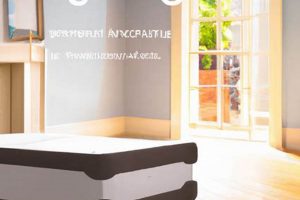
![Best Split King Size Mattress [Guide] + Benefits Organic & Natural Mattress Buyer’s Guide: Non-Toxic Sleep Solutions Best Split King Size Mattress [Guide] + Benefits | Organic & Natural Mattress Buyer’s Guide: Non-Toxic Sleep Solutions](https://mattressworldpa.com/wp-content/uploads/2025/07/th-8165-300x200.jpg)
